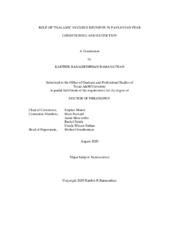| dc.contributor.advisor | Maren, Stephen | |
| dc.creator | Ramanathan, Karthik Ramakrishnan | |
| dc.date.accessioned | 2021-02-19T22:04:01Z | |
| dc.date.available | 2022-08-01T06:54:22Z | |
| dc.date.created | 2020-08 | |
| dc.date.issued | 2020-07-01 | |
| dc.date.submitted | August 2020 | |
| dc.identifier.uri | https://hdl.handle.net/1969.1/192493 | |
| dc.description.abstract | Stress and anxiety disorders such as posttraumatic stress disorder (PTSD) pose a significant burden to the society. Existing cognitive-behavioral treatments are centered around exposure therapy which, while effective in the clinic, is susceptible to relapse (return of fear). This is because exposure therapy does not erase the underlying fear memory, rather it yields an inhibitory, context-dependent “extinction” memory that competes with the fear memory. Hence, considerable research has focused on understating this context dependence of the extinction memories in an attempt to prevent relapse. However, the mechanism of this fear inhibition is still relatively unknown. When human subjects actively try to suppress memory retrieval, medial prefrontal cortex (mPFC) activation is correlated with hippocampal (HPC) suppression. In rodents, data from a variety of behavioral paradigms have shown that the PFC interacts with the HPC via the thalamic nucleus reuniens (RE). Here I explored the contribution of RE to the conditioning and extinction of conditioned fear in rats. I first show that RE is critical for acquisition and precision of contextual fear memories. Importantly, I show that RE inactivation renders a contextual fear memory that is acquired independently of the hippocampus. I then show that RE is critically involved in both acquisition and expression of fear extinction. Circuit-specific manipulations showed projections form the mPFC to RE are critical for fear extinction. Finally, using intersectional optogenetic methods, I find evidence that RE projections to both the mPFC and HPC are involved in extinction retrieval. Collectively, these data reveal a critical role for RE in contextual memory precision and context-dependent extinction that may be mediated through mPFC-HPC interactions. | en |
| dc.format.mimetype | application/pdf | |
| dc.language.iso | en | |
| dc.subject | Fear Conditioning | en |
| dc.subject | Fear Extinction | en |
| dc.subject | PTSD | en |
| dc.subject | Nucleus Reuniens | en |
| dc.subject | Mid-line Thalamus | en |
| dc.title | Role of Thalamic Nucleus Reuniens in Pavlovian Fear Conditioning and Extinction | en |
| dc.type | Thesis | en |
| thesis.degree.department | Neuroscience | en |
| thesis.degree.discipline | Neuroscience | en |
| thesis.degree.grantor | Texas A&M University | en |
| thesis.degree.name | Doctor of Philosophy | en |
| thesis.degree.level | Doctoral | en |
| dc.contributor.committeeMember | Packard, Mark | |
| dc.contributor.committeeMember | Smith, Rachel | |
| dc.contributor.committeeMember | Moscarello, Justin | |
| dc.contributor.committeeMember | Winzer-Serhan, Ursula | |
| dc.type.material | text | en |
| dc.date.updated | 2021-02-19T22:04:02Z | |
| local.embargo.terms | 2022-08-01 | |
| local.etdauthor.orcid | 0000-0002-8843-3665 | |


